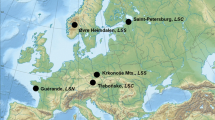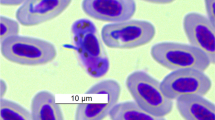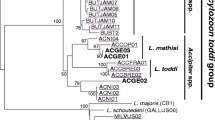Abstract
Knowledge of the factors influencing the patterns and distribution of parasite infections and disease outbreaks is a major question in disease ecology and conservation research. In this study, we use a highly efficient PCR approach to detect blood parasites and investigate the factors influencing geographical variation in the distribution of leucocytozoids parasitizing nestling eagle owls (Bubo bubo) over a 3-year study period. We found that both prevalence and intensity of infections by the single lineage of Leucocytozoon ziemanni infecting nestling eagle owls in the study area increased with local owl population density and decreased with nest height above sea level. Overall, these results suggest that higher horizontal transmission rates under higher host density conditions together with the presence of adequate habitats for larval development of vectors are relevant factors influencing blood parasite distribution in the study system.


Similar content being viewed by others
References
Afrane YA, Zhou GF, Lawson BW, Githeko AK, Yan GY (2006) Effects of microclimatic changes caused by deforestation on the survivorship and reproductive fitness of Anopheles gambiae in Western Kenya highlands. Am J Trop Med Hyg 74:772–778
Anderson RM, May RM (1979) Population biology of infectious diseases. 1. Nature 280:361–367
Arneberg P, Skorping A, Grenfell B, Read AF (1998) Host densities as determinants of abundance in parasite communities. Proc R Soc Lond B 265:1283–1289
Ashford RW, Wyllie I, Newton I (1990) Leucocytozoon toddi in British sparrowhawks Accipiter nisus—observations on the dynamics of infection. J Nat Hist 24:1101–1107
Atkinson CT, Dusek RJ, Lease JK (2001a) Serological responses and immunity to superinfection with avian malaria in experimentally-infected Hawaii Amakihi. J Wildlife Dis 37:20–27
Atkinson CT, Lease JK, Drake BM, Shema NP (2001b) Pathogenicity, serological responses, and diagnosis of experimental and natural malarial infections in native Hawaiian thrushes. Condor 103:209–218
Balls MJ, Bodker R, Thomas CJ, Kisinza W, Msangeni HA, Lindsay SW (2004) Effect of topography on the risk of malaria infection in the Usambara Mountains, Tanzania. Trans R Soc Trop Med Hyg 98:400–408
Bensch S, Stjernman M, Hasselquist D, Ostman O, Hansson B, Westerdahl H, Pinheiro RT (2000) Host specificity in avian blood parasites: a study of Plasmodium and Haemoproteus mitochondrial DNA amplified from birds. Proc R Soc Lond B 267:1583–1589
Bensch S, Waldenström J, Jonzen N, Westerdahl H, Hansson B, Sejberg D, Hasselquist D (2007) Temporal dynamics and diversity of avian malaria parasites in a single host species. J Anim Ecol 76:112–122
Bermejo M, Rodriguez-Teijeiro JD, Illera G, Barroso A, Vila C, Walsh PD (2006) Ebola outbreak killed 5000 gorillas. Science 314:1564
Bolker BM, Brooks ME, Clark CJ, Geange SW, Poulsen JR, Stevens MHH, White JSS (2009) Generalized linear mixed models: a practical guide for ecology and evolution. Trends Ecol Evol 24:127–135
Ellegren H (1996) First gene on the avian W chromosome (CHD) provides a tag for universal sexing of non-ratite birds. Proc R Soc Lond B 263:1635–1641
Finn DS, Theobald DM, Black WC, Poff NL (2006) Spatial population genetic structure and limited dispersal in a Rocky Mountain alpine stream insect. Mol Ecol 15:3553–3566
Githeko AK, Ayisi JM, Odada PK, Atieli FK, Ndenga BA, Githure JI, Yan GY (2006) Topography and malaria transmission heterogeneity in western Kenya highlands: prospects for focal vector control. Malar J 5:107
Hall TA (1999) BioEdit: a user-friendly biological sequence alignment editor and analysis program for Windows 95/98/NT. Nucleic Acids Symp Ser 41:95–98
Hellgren O, Waldenström J, Bensch S (2004) A new PCR assay for simultaneous studies of Leucocytozoon, Plasmodium, and Haemoproteus from avian blood. J Parasitol 90:797–802
Hellgren O, Waldenström J, Pérez-Tris J, Szollosi E, Hasselquist D, Krizanauskiene A, Ottosson U, Bensch S (2007) Detecting shifts of transmission areas in avian blood parasites—a phylogenetic approach. Mol Ecol 16:1281–1290
Hellgren O, Bensch S, Malmqvist B (2008) Bird hosts, blood parasites and their vectors—associations uncovered by molecular analyses of blackfly blood meals. Mol Ecol 17:1605–1613
Ishak HD, Dumbacher JP, Anderson NL, Keane JJ, Valkiūnas G, Haig SM, Tell LA, Sehgal RNM (2008) Blood parasites in owls with conservation implications for the spotted owl (Strix occidentalis). PLoS ONE 3:e2304
Jarvi SI, Farias MEM, Baker H, Freifeld HB, Baker PE, Van Gelder E, Massey JG, Atkinson CT (2003) Detection of avian malaria (Plasmodium spp.) in native land birds of American Samoa. Conserv Genet 4:629–637
Koenraadt CJM, Paaijmans KP, Schneider P, Githeko AK, Takken W (2006) Low larval vector survival explains unstable malaria in the western Kenya highlands. Trop Med Int Health 11:1195–1205
Korpimäki E, Hakkarainen H, Bennett GF (1993) Blood parasites and reproductive success of tengmalm owls—detrimental effects on females but not on males. Funct Ecol 7:420–426
Krackow S, Tkadlec E (2001) Analysis of brood sex ratios: implications of offspring clustering. Behav Ecol Sociobiol 50:293–301
Krone O, Waldenström J, Valkiūnas G, Lessow O, Muller K, Iezhova TA, Fickel J, Bensch S (2008) Haemosporidian blood parasites in European birds of prey and owls. J Parasitol 94:709–715
Little RM, Earlé RA (1995) Sandgrouse (Pterocleidae) and sociable weavers Philetarius socius lack avian haematozoa in semi-arid regions of South Africa. J Arid Environ 30:367–370
Malmqvist B, Zhang YX, Adler PH (1999) Diversity, distribution and larval habitats of North Swedish blackflies (Diptera : Simuliidae). Freshwater Biol 42:301–314
Marchesi L, Sergio F, Pedrini P (2002) Costs and benefits of breeding in human-altered landscapes for the eagle owl Bubo bubo. Ibis 144:E164–E177
Martinsen ES, Perkins SL, Schall JJ (2008) A three-genome phylogeny of malaria parasites (Plasmodium and closely related genera): Evolution of life-history traits and host switches. Mol Phylogen Evol 47:261–273
Marzal A, Bensch S, Reviriego M, Balbontin J, de Lope F (2008) Effects of malaria double infection in birds: one plus one is not two. J Evol Biol 21:979–987
May RM, Anderson RM (1979) Population biology of infectious diseases. 2. Nature 280:455–461
Møller AP (1997) Parasitism and the evolution of host life history. In: Clayton DH, Moore J (eds) Host–parasite evolution: general principles and avian models. Oxford University Press, Oxford, pp 105–127
Ojanen U, Ratti O, Adler PH, Kuusela K, Malmqvist B, Helle P (2002) Blood feeding by black flies (Diptera : Simuliidae) on black grouse (Tetrao tetrix) in Finland. Entomol Fennica 13:153–158
Omumbo JA, Hay SI, Snow RW, Tatem AJ, Rogers DJ (2005) Modelling malaria risk in East Africa at high-spatial resolution. Trop Med Int Health 10:557–566
Ortego J (2007) Consequences of eagle owl nest-site habitat preference for breeding performance and territory stability. Ornis Fennica 84:78–90
Ortego J, Cordero PJ (2009) PCR-based detection and genotyping of haematozoa (Protozoa) parasitizing eagle owls, Bubo bubo. Parasitol Res 104:467–470
Ortego J, Diaz M (2004) Habitat preference models for nesting eagle owls Bubo bubo: How much can be inferred from changes with spatial scale? Ardeola 51:385–394
Ortego J, Espada F (2007) Ecological factors influencing disease risk in eagle owls Bubo bubo. Ibis 149:386–395
Ortego J, Espada F, Baquero RA (2007a) Ecology of parasitism of nestling Eurasian eagle-owls (Bubo Bubo) by Leucocytozoon ziemanni. J Raptor Res 41:247–251
Ortego J, Cordero PJ, Aparicio JM, Calabuig G (2007b) No relationship between individual genetic diversity and prevalence of avian malaria in a migratory kestrel. Mol Ecol 16:4858–4866
Ortego J, Cordero PJ, Aparicio JM, Calabuig G (2008) Consequences of chronic infections with three different avian malaria lineages on reproductive performance of lesser kestrels (Falco naumanni). J Ornithol 149:337–343
Pagenkopp KM, Klicka J, Durrant KL, Garvin JC, Fleischer RC (2008) Geographic variation in malarial parasite lineages in the common yellowthroat (Geothlypis trichas). Conserv Gen 9:1577–1588
Paul REL, Hackford I, Brockman A, Muller-Graf C, Price R, Luxemburger C, White NJ, Nosten F, Day KP (1998) Transmission intensity and Plasmodium falciparum diversity on the northwestern border of Thailand. Am J Trop Med Hyg 58:195–203
Penteriani V, Delgado MD, Gallardo M, Ferrer M (2004) Spatial heterogeneity and structure of bird populations: a case example with the eagle owl. Popul Ecol 46:185–192
Penteriani V, Delgado MM, Maggio C, Aradis A, Sergio F (2005) Development of chicks and predispersal behaviour of young in the eagle owl Bubo bubo. Ibis 147:155–168
Pérez-Tris J, Hellgren O, Krizanauskiene A, Waldenström J, Secondi J, Bonneaud C, Fjeldsa J, Hasselquist D, Bensch S (2007) Within-host speciation of malaria parasites. PLoS ONE 2:e-235
Perkins SL, Schall JJ (2002) A molecular phylogeny of malarial parasites recovered from cytochrome b gene sequences. J Parasitol 88:972–978
Ricklefs RE, Swanson BL, Fallon SM, Martinez-Abrain A, Scheuerlein A, Gray J, Latta SC (2005) Community relationships of avian malaria parasites in southern missouri. Ecol Monogr 75:543–559
Rohner C, Krebs CJ, Hunter DB, Currie DC (2000) Roost site selection of great horned owls in relation to black fly activity: an anti-parasite behavior? Condor 102:950–955
SAS Institute (2004) SAS/STAT 9.1 user’s guide. SAS Institute Inc, Cary
Schall JJ, Vardo AM (2007) Identification of microsatellite markers in Plasmodium mexicanum, a lizard malaria parasite that infects nucleated erythrocytes. Mol Ecol Notes 7:227–229
Sehgal RNM, Hull AC, Anderson NL, Valkiūnas G, Markovets MJ, Kawamura S, Tell LA (2006) Evidence for cryptic speciation of Leucocytozoon spp. (Haemosporida, Leucocytozoidae) in diurnal raptors. J Parasitol 92:375–379
Snow D, Perrins C (1998) The complete birds of the Western Palearctic on CD-ROM. Oxford University Press, Oxford
Su T, Mulla MS (2001) Effects of temperature on development, mortality, mating and blood feeding behavior of Culiseta incidens (Diptera: Culicidae). J Vector Ecol 26:83–92
Tella JL, Blanco G, Forero MG, Gajón A, Donázar JA, Hiraldo F (1999) Habitat, world geographic range, and embryonic development of host explain the prevalence of avian hematozoa at small spatial and phylogenetics scales. Proc Natl Acad Sci USA 96:1785–1789
Thompson BH (1976) Studies on flight range and dispersal of Simulium damnosum (Diptera-Simuliidae) in rain-forest of Cameroon. Ann Trop Med Parasitol 70:343–354
Valkiūnas G (2004) Avian malarial parasites and other haemosporidia. Taylor and Francis Publishing, London
Valkiūnas G, Bensch S, Iezhova TA, Krizanauskiene A, Hellgren O, Bolshakov CV (2006) Nested cytochrome B polymerase chain reaction diagnostics underestimate mixed infections of avian blood haemosporidian parasites: microscopy is still essential. J Parasitol 92:418–422
Van Riper III C, Vanriper SG, Goff ML, Laird M (1986) The epizootiology and ecological significance of malaria in Hawaiian land birds. Ecol Monogr 56:327–344
Vardo AM, Schall JJ (2007) Clonal diversity of a lizard malaria parasite, Plasmodium mexicanum, in its vertebrate host, the western fence lizard: role of variation in transmission intensity over time and space. Mol Ecol 16:2712–2720
Waldenström J, Bensch S, Hasselquist D, Ostman O (2004) A new nested polymerase chain reaction method very efficient in detecting Plasmodium and Haemoproteus infections from avian blood. J Parasitol 90:191–194
Wood MJ, Cosgrove CL, Wilkin TA, Knowles SCL, Day KP, Sheldon BC (2007) Within-population variation in prevalence and lineage distribution of avian malaria in blue tits, Cyanistes caeruleus. Mol Ecol 16:3263–3273
Woodworth BL, Atkinson CT, LaPointe DA, Hart PJ, Spiegel CS, Tweed EJ, Henneman C, LeBrun J, Denette T, DeMots R, Kozar KL, Triglia D, Lease D, Gregor A, Smith T, Duffy D (2005) Host population persistence in the face of introduced vector-borne diseases: Hawaii amakihi and avian malaria. Proc Natl Acad Sci USA 102:1531–1536
Zahar AR (1951) The ecology and distribution of black-flies (Simuliidae) in south-east Scotland. J Anim Ecol 20:33–62
Acknowledgments
We wish to thank F. Espada for determining blood parasite prevalence and intensities of infections in the blood smears. Four anonymous referees and the associate editor of Conservation Genetics provided valuable comments that improved the manuscript. This work received financial support from the projects: CGL2005-05611-C02-02/BOS (Ministerio de Educación y Ciencia), PAI05-053 (Junta de Comunidades de Castilla-La Mancha), and PCI08-0130-3954 (Junta de Comunidades de Castilla-La Mancha). We manipulated, bled, and banded nestling eagle owls under license from the Spanish institutional authorities (Environmental Agency of Junta de Comunidades de Castilla-La Mancha and the Ringing Office of the Ministry of Environment) and we followed general ethical guidelines for animal welfare and nature conservation. During this work J.O. was supported by a post-doctoral JAE-Doc (CSIC) contract. We performed all the laboratory work at the Laboratory of Genetics of the IREC and fragment genotyping was performed by the Centro de Investigaciones Biológicas (CSIC) of Madrid.
Author information
Authors and Affiliations
Corresponding author
Rights and permissions
About this article
Cite this article
Ortego, J., Cordero, P.J. Factors associated with the geographic distribution of leucocytozoa parasitizing nestling eagle owls (Bubo bubo): a local spatial-scale analysis. Conserv Genet 11, 1479–1487 (2010). https://doi.org/10.1007/s10592-009-9978-x
Received:
Accepted:
Published:
Issue Date:
DOI: https://doi.org/10.1007/s10592-009-9978-x




